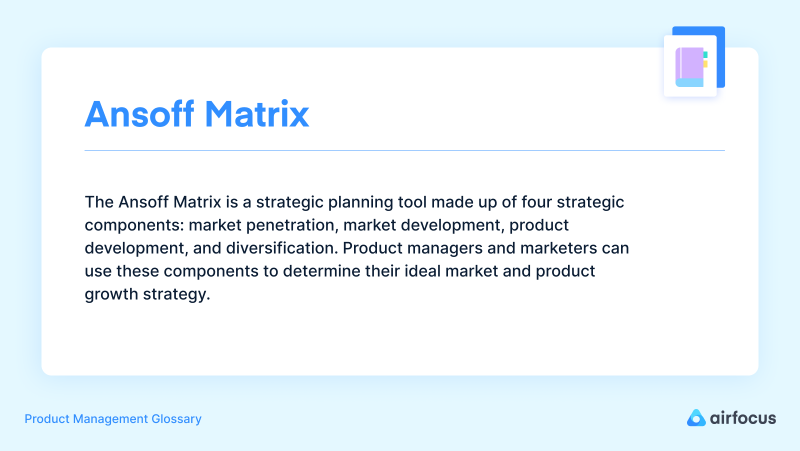Ansoff Matrix
What is the Ansoff Matrix?
Ansoff Matrix definition
The Ansoff Matrix is a strategic planning tool made up of four strategic components: market penetration, market development, product development, and diversification. Product managers and marketers can use these components to determine their ideal market and product growth strategy.
The Ansoff Matrix was created by Igor Ansoff, a Russian-American business manager and applied mathematician. He created these four strategies to help businesses grow in a new or existing market with new or existing products.
What are the components of the Ansoff Matrix?
The Ansoff Matrix is a two by two grid of four strategies that help guide growth and identify risks:
Market penetration: Market penetration focuses on boosting the sales of existing products in an existing market, mainly by using promotions and advertisements. Since you already know about your existing product and market, this strategy involves the least risk.
Market development: Market development looks at introducing your existing products to a new market, making it slightly riskier than market penetration.
Product development: In product development, you introduce a new product to an existing market. This strategy is riskier than market development and market penetration due to uncertain demand, competition, and market saturation.
Diversification: Diversification involves selling or marketing new products in new markets. In this strategy, you have limited information about your new product and the new market, making it the riskiest strategy of the four.
What is the Ansoff Matrix used for?
The Ansoff Matrix is used to make product management and product development more effective.
For example, it helps product managers analyze and identify the strategies that align with your company’s goals, resources, and capabilities. Additionally, the Ansoff Matrix provides a structured framework that helps product development teams analyze the risk potential of different growth strategies.
Example of the Ansoff Matrix
Coca-Cola
Coca-Cola is a global beverage corporation with numerous products in a diverse market. How did this happen?
Initially, Coca-Cola focused on increasing its sales by selling existing products in the existing market more aggressively. This approach is market penetration.
After that, Coca-Cola started introducing new products (Diet coke, Coke Zero, etc.) in their existing market, which helped increase their customer base and capture a bigger market. This approach is product development.
Finally, Coca-Cola focused on introducing new products to a new market by diversifying its business to other countries like China and India. This approach is diversification.
Criticisms and considerations when using the Ansoff Matrix
Consider these disadvantages before implementing Ansoff Matrix in your organization:
Ignores competitors: While the Ansoff Matrix considers your products and market carefully, it fails to consider the competition.
Uncertainty: Even when you choose the right Ansoff strategy, predicting its impact on your company’s sales and profits will always involve some level of uncertainty and risk. After all, you never know exactly how customers or the market will react.
No provision of cost-benefit analysis: The Ansoff Matrix doesn’t explicitly include a cost-benefit analysis. So, if you rely on it blindly, you might spend way more than you should.


Glossary categories
Create effective product strategy

Experience the new way of doing product management








